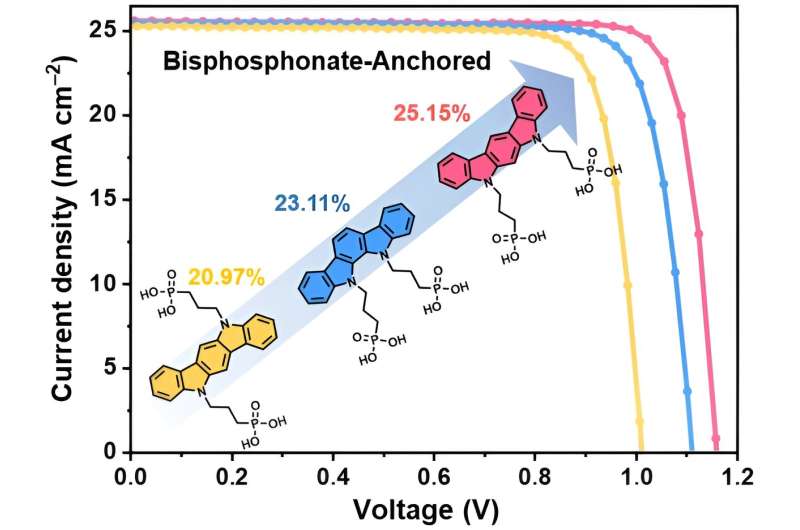
MAY 30, 2024 by Zhang Nannan, Chinese Academy of Sciences
Collected at : https://techxplore.com/news/2024-05-perovskite-solar-cells-efficiency.html
A research group led by Prof. Ge Ziyi from the Ningbo Institute of Materials Technology and Engineering (NIMTE) of the Chinese Academy of Sciences has developed three isomeric bisphosphonate-anchored self-assembled molecules (SAMs) to achieve highly efficient and stable inverted perovskite solar cells (PSCs). The work was published in Advanced Materials.
Perovskite solar cells have attracted much attention as a promising green energy technology due to their low fabrication cost and extraordinary power conversion efficiencies (PCEs).
The wettability, absorbability and compactness of SAMs, which are used as hole-transporting layers (HTLs) for PSCs, critically affect the efficiency and stability of the devices. Therefore, the researchers proposed a molecular strategy to synthesize three bisphosphonate-anchored indolocarbazole (IDCz)-derived SAMs, namely IDCz-1, IDCz-2, and IDCz-3.
The three SAMs with different positions of the two nitrogen atoms in the IDCz unit were each employed on conductive oxide substrates for inverted PSCs.
Compared with IDCz-1 and IDCz-2, IDCz-3 exhibited larger dipole moment, higher energy level and larger water contact angles, which contributed to the hole extraction and electron blocking.
As a result, the inverted PSC with IDCz-3 as HTL achieved a record high PCE of 25.15%, which is the highest value reported to date for multipodal SAMs-based PSCs.
When stored in a nitrogen environment at room temperature for 1,800 hours, the IDCz-3-based device can almost maintain its initial efficiency, indicating its excellent long-term stability.
More information: Jie Wu et al, Bisphosphonate‐Anchored Self‐Assembled Molecules with Larger Dipole Moments for Efficient Inverted Perovskite Solar Cells with Excellent Stability, Advanced Materials (2024). DOI: 10.1002/adma.202401537
Journal information: Advanced Materials

Leave a Reply